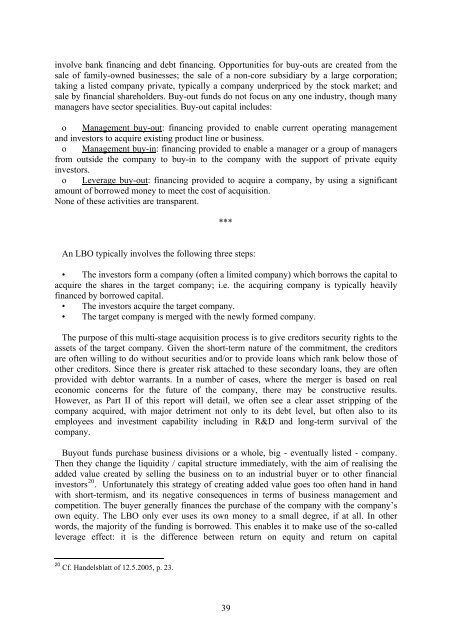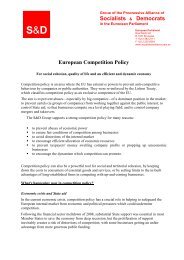Executive summary - Udo Bullmann
Executive summary - Udo Bullmann
Executive summary - Udo Bullmann
- No tags were found...
Create successful ePaper yourself
Turn your PDF publications into a flip-book with our unique Google optimized e-Paper software.
involve bank financing and debt financing. Opportunities for buy-outs are created from thesale of family-owned businesses; the sale of a non-core subsidiary by a large corporation;taking a listed company private, typically a company underpriced by the stock market; andsale by financial shareholders. Buy-out funds do not focus on any one industry, though manymanagers have sector specialities. Buy-out capital includes:o Management buy-out: financing provided to enable current operating managementand investors to acquire existing product line or business.o Management buy-in: financing provided to enable a manager or a group of managersfrom outside the company to buy-in to the company with the support of private equityinvestors.o Leverage buy-out: financing provided to acquire a company, by using a significantamount of borrowed money to meet the cost of acquisition.None of these activities are transparent.***An LBO typically involves the following three steps:• The investors form a company (often a limited company) which borrows the capital toacquire the shares in the target company; i.e. the acquiring company is typically heavilyfinanced by borrowed capital.• The investors acquire the target company.• The target company is merged with the newly formed company.The purpose of this multi-stage acquisition process is to give creditors security rights to theassets of the target company. Given the short-term nature of the commitment, the creditorsare often willing to do without securities and/or to provide loans which rank below those ofother creditors. Since there is greater risk attached to these secondary loans, they are oftenprovided with debtor warrants. In a number of cases, where the merger is based on realeconomic concerns for the future of the company, there may be constructive results.However, as Part II of this report will detail, we often see a clear asset stripping of thecompany acquired, with major detriment not only to its debt level, but often also to itsemployees and investment capability including in R&D and long-term survival of thecompany.Buyout funds purchase business divisions or a whole, big - eventually listed - company.Then they change the liquidity / capital structure immediately, with the aim of realising theadded value created by selling the business on to an industrial buyer or to other financialinvestors 20 . Unfortunately this strategy of creating added value goes too often hand in handwith short-termism, and its negative consequences in terms of business management andcompetition. The buyer generally finances the purchase of the company with the company’sown equity. The LBO only ever uses its own money to a small degree, if at all. In otherwords, the majority of the funding is borrowed. This enables it to make use of the so-calledleverage effect: it is the difference between return on equity and return on capital20 Cf. Handelsblatt of 12.5.2005, p. 23.39





